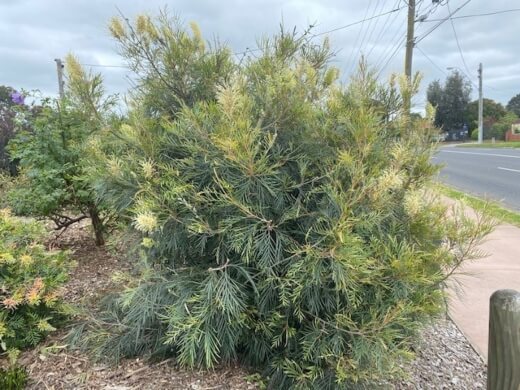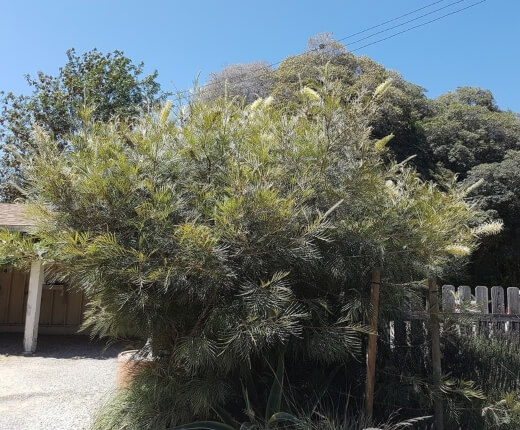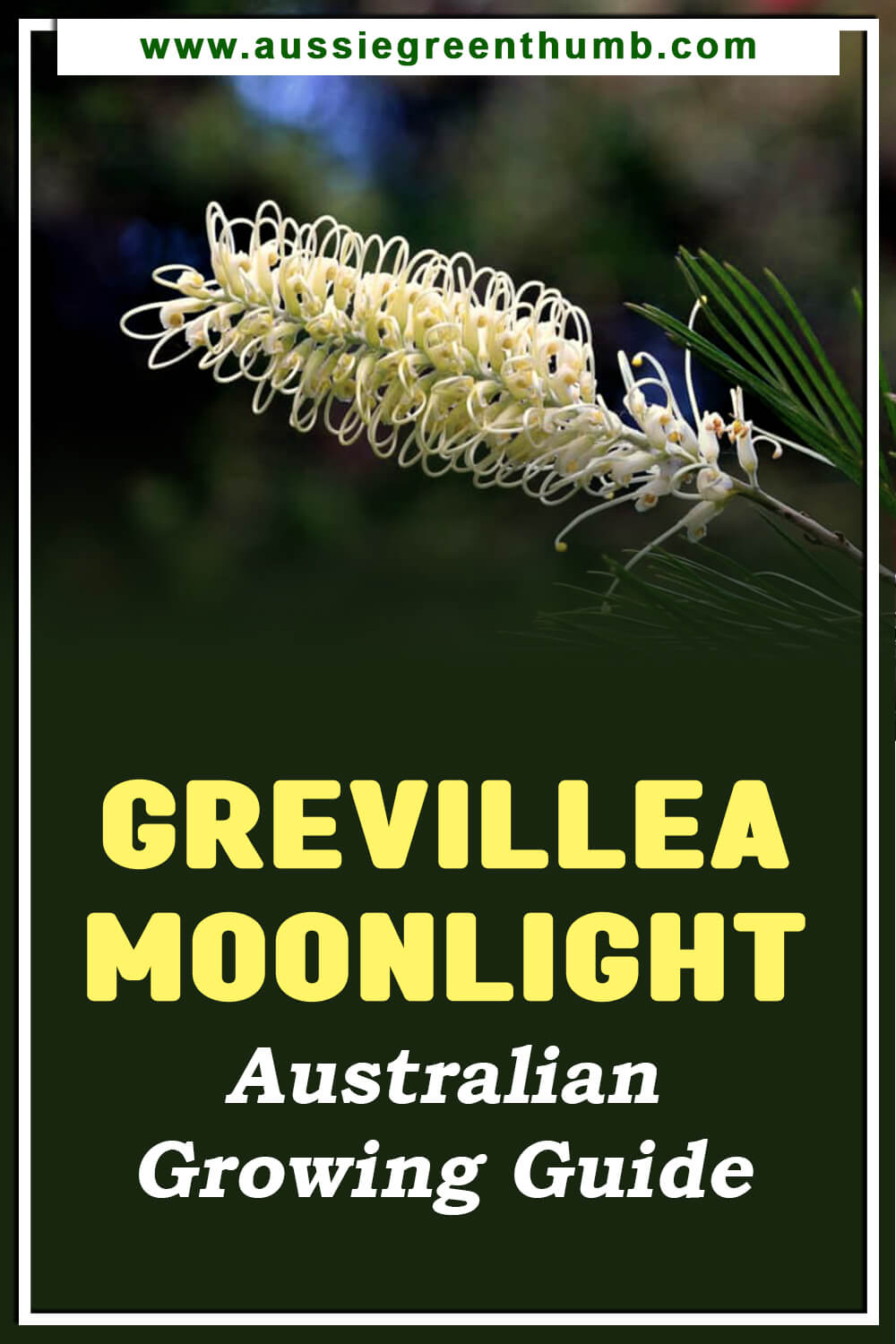Any plant that has the word ‘moonlight’ in the name such as the Grevillea ‘Moonlight’, evokes a feeling of wonder. It points to something much greater than us, and of course, is distinctly beautiful.
Grevillea ‘Moonlight’ adds lovely colour to a native garden and attracts birds too. As the cousin of the South African Protea, this is our very own proudly Australian native.
Our guide about the Grevillea ‘Moonlight’ cultivar covers the features of this shrub/tree, a growing and care guide, advice on pests and diseases to look out for, and some interesting FAQs where you can learn more about this beauty.
More...

Genus: | Grevillea |
|---|---|
Species: | Selected form of Grevillea whiteana |
Family: | Proteaceae |
Common name: | Grevillea ‘Moonlight’ |
Plant type: | Shrub |
Height: | Up to 3.6 metres |
Width: | Up to 2.4 metres |
Sun: | Full or partial sunlight |
Soil: | Loam, sand, well-drained |
Soil pH: | Acid, neutral |
Flower colour: | Cream |
Maintenance: | Low |
Toxic: | Yes, can cause skin irritation |
Introducing Grevillea ‘Moonlight’
Grevilleas are the largest genus in the Proteaceae family – that means they are closely related to the South African Proteas, Australian Hakeas and the ivory curl flower (Buckinghamia). There are only a few not native to Australia, with some coming from Papua New Guinea and New Caledonia.
Grevillea ‘Moonlight’ specifically is widely cultivated and a popular garden plant in Australia. It’s actually a selected form of the Queensland species Grevillea whiteana, although it doesn’t look much like the parent plant.
Grevillea ‘Moonlight’ is a large bushy shrub that can be trained as a tree. It’s a very hardy Grevillea and was one of the first tall-grevillea cultivars, growing up to 4 metres high, and is much loved by birds and insects. The shrub can handle humidity and frost, and it might need some heavy pruning so it doesn’t get top heavy.
This particular grevillea has a unique foliage and flower colour in comparison to other grevilleas. It is fast growing and ideal for background areas to create a screen and on a slope. The shrub works well as a feature plant and does well with other plants too.
Grevillea ‘Moonlight’ grows well in full sun and afternoon shade, and they only need a small H2O boost. We would call it a relatively low maintenance and easy care plant as it tolerates a range of soils (as long as there is good drainage) and grows in a variety of climates.
The fact that Grevillea ‘Moonlight’ flowers all year round (depending on location) makes it incredibly popular.
Features of Grevillea ‘Moonlight’
The leaves have a feathery appearance, with a deep green colour on top and a silver colour underneath. The amazing flower clusters have no petals and usually look like one of the following:
- Toothbrush (stamens and styles grow on one side of the stem), spider (stamens and styles look like spider legs), or brush (evenly arranged stamens and styles). All of these can flower throughout the year, including winter.
- The foliage can be sharp needles, deeply lobed, fat blobs, or fern-like.
Looking to add more blooms to your garden? Have a look through our flowering plants articles for inspiration and to make the right choice for your garden and home.
How to Grow Grevillea ‘Moonlight’
Grevilleas grow all over Australia and they easily interbreed, which means you can generally get the flower you want for the climate where you live.

Source: gardenfeast.com.au
Sunlight
Grevillea ‘Moonlight’ shrubs love the sun, so plant them in full sun and keep them sheltered from strong winds. The plant will tolerate some shade but you’ll find it more open and will produce less flowers.


Get Your Free Guide:
Master Growing Australian Natives eBook
A Must Have Complete Guide for Every Australian Garden
Get Your Free Guide:
Master Growing Australian Natives eBook
A Must Have Complete Guide for Every Australian Garden
Climate
Grevilleas will grow in most climates but ability to handle cold and frost varies between species.
Best Soil to Use
Grevillea ‘Moonlight’ needs well-drained soil. You could build raised garden beds to help the plant, and the soil along. Poor drainage or overwatering can cause root rot.
Grevillea ‘Moonlight’ in particular is more tolerant of wet soils than most Grevillea and they are resistant to Phytophthora cinnamon.
Caring for Grevillea ‘Moonlight’

Watering Schedule
When planting your Grevillea ‘Moonlight’ you need to water it well for the first six months. After that, you can move onto watering twice a week for two to three weeks, then once a week for about four weeks.
Water more often when the weather is hot and dry and less in winter or cooler, moist conditions. When your Grevillea ‘Moonlight’ is established it will be able to handle periods of drought.
Ultimately, if you keep watering even during dry periods, your plant will grow and flower better.
What Fertiliser to Use
A few weeks before you plant your Grevillea ‘Moonlight’, you can add well-aged cow manure to the soil. Avoid using fresh manures, as these can burn the plant roots.
You also want to avoid fertilisers with phosphorous as the plant is sensitive to high levels. It’s best to opt for a specialised native fertiliser. You can apply a small amount of native plant fertiliser in early spring and again in late summer.
Mulching
A layer of mulch over garden beds will help retain soil moisture, keep weeds under control, and protect roots. Use organic mulch like compost or lucerne and spread it about 50mm deep around the plants.
Try not to pile mulch around the stems and it shouldn’t touch the trunk. Aim to leave a ring of about 10cm across.
Pruning Grevillea ‘Moonlight’
It’s vital to prune your Grevillea ‘Moonlight’ to keep it looking its best, and to encourage flowering. The best time to do this is after the flowers have withered and this usually occurs in late winter.
You can prune the shrub by about a third to improve the shape, create denser foliage and even more flowering. What’s great about this plant is that it can be pruned back very hard and it will re shoot.
If you’re cutting into hard old wood, do it in late autumn and give the plant a good watering to help it along. Check out our review on the best pruning saws to help you accomplish this task.
If you are doing a light trim, you can cut behind the withered flowers, but the Grevillea ‘Moonlight’ can completely rejuvenate when you deadhead and cut the branches back, also removing any branches that spoil the shape of the bush.
Propagating Grevillea ‘Moonlight’
Grevilleas can be propagated from cuttings. (Learn all about taking cuttings).

Source: davesgarden.com
Here are your steps to follow:
- Make cuttings of about 10 centimetres in length. You want to choose firm, semi-ripe shoots and the best time for this is during summer or early autumn.
- Next, you’re going to dip the cuttings into root growth hormone.
- Fill a container with coarse sand and place the cuttings into the container.
- Water the cutting gently and be careful not to overwater.
- Keep the cuttings away from direct sunlight and inside a sheltered plastic container if it's cold.
- Use a spray mister to finely mist the cuttings regularly. It can be at least six months before you see any signs of roots.
Pests and Diseases that Affect Grevillea ‘Moonlight’

Source: plant-material.com
- Borers – if the plant looks stressed and there is sawdust around a hole, you probably have borer. Neem oil kills a wide variety of insects and can be used on the plant
- Grevillea Leaf Miner – this can lead to premature leaf drop. We recommend that you spray with a horticultural oil to prevent the moth from laying new eggs.
The oil doesn’t kill the larvae so it’s vital to remove any infested growth. Spray first thing in the morning – this means you won’t accidentally take out the beneficial insects, and it also reduces the chance of burning foliage. - Cottony cushion scale – this pest can ultimately affect the leaf's ability to photosynthesize. A method that works (but can be tiresome) is to rub the leaves with a cotton swab dipped in rubbing alcohol. This is very effective if you are persistent about it.
Hot water is another way to kill mealybugs and cottony cushion scales. Prune and dispose of infested branches, twigs and leaves and when scale numbers are low you can pick them off by hand.
Dabbing individual pests with an alcohol-soaked cotton swab or neem-based oil will also work when infestations are light. - Leaf Spot Fungus – this usually happens in warm, humid conditions and can once again be treated with neem oil once you have removed affected growth.
- Painted Apple Moth - one of the best natural ways to get rid of these moths is to spray with neem oil every two weeks for as long as necessary.
- Phytophthora Dieback - this soil fungus invades the roots and starves them of food and water. Prune out dead or dying branches and disinfect the pruning tool between cuts using 10% household bleach, 70% alcohol, or a disinfectant product. A good time to prune is late in the dormant season.
Grevillea ‘Moonlight’ Frequently Asked Questions

How many species of Grevillea are there?
There are about 250 species of Grevillea and most of them are found in Australia. We can break it down further to say that 135 species are from South-Western Australia, 70 from South-Eastern Australia, 45 from the tropics, and 25 species in semi-arid or arid areas.
Does Grevillea have any kind of historical significance?
Grevillea flowers were a traditional favourite for their sweet nectar. They could be shaken onto the hand to taste, or mixed with a little water to make a sweet drink. They are sometimes referred to as the original “bush lollies”.
Does Grevillea ‘Moonlight’ cause an allergic reaction?
This cultivar of Grevillea is very similar to several other cultivars which can cause allergic contact dermatitis for some people, so just proceed with caution.
Where did the Grevillea ‘Moonlight’ get its name?
Grevillea was named after Charles Francis Greville (1749-1809), an 18th-century patron of botany and the co-founder of the Royal Horticultural Society. He was also a British politician who sat in the House of Commons from 1774 to 1790. ‘Moonlight’ is named for the colour of the cluster of flowers.
Do Grevillea ‘Moonlight’ flowers look good in a vase?
This plant is great as a cut flower. Just be sure to harvest it when the buds are just starting to open.
How can I make a homemade fertiliser for my Grevillea ‘Moonlight’?
DIY organic mulch or compost is best. You can create homemade mulch from low-phosphorus organic matter like pine bark, or use manure compost. A reminder to check the phosphorus requirements of your plant first.
What is the smallest Grevillea?
This would be the ‘Pink Midget’ as it grows low and spreads well as a great groundcover. This compact shrub grows up to 30cm in height and can spread up to 1 metre across.
What is the hardiest Grevillea?
Grevillea ‘Lady O’ Climate is incredibly frost hardy to at least -50°C but can also do well in warmer climates and even higher levels of humidity. Its average size is 1-1.5meters high by 2 metres wide.

Grow Gorgeous Grevillea ‘Moonlight’
If you’re a gardener who already feels proudly Australian, the Grevillea ‘Moonlight’ is another reason to add to your list. This beautiful native shrub is a year round bloomer, with plenty of character. They look gorgeous in a vase, in a pot, as a garden screen, or mixed up with some evergreens.
You can nurture your own Grevillea ‘Moonlight’ from a cutting, and even if you forget to water them for a while (thank goodness they’re drought resistant), you’ll still have a lovely native plant in your garden family. We’re giving the Grevillea ‘Moonlight’ our green thumbs up.
Published on May 28, 2022 by Nathan Schwartz
Last Updated on October 4, 2024




